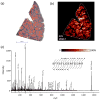MALDI imaging mass spectrometry of human tissue: method challenges and clinical perspectives
- PMID: 21292337
- PMCID: PMC3072073
- DOI: 10.1016/j.tibtech.2010.12.002
MALDI imaging mass spectrometry of human tissue: method challenges and clinical perspectives
Abstract
The molecular complexity of biological tissue and the spatial and temporal variation in the biological processes involved in human disease requires new technologies and new approaches to provide insight into disease processes. Imaging mass spectrometry is an effective tool that provides molecular images of tissues in the molecular discovery process. The analysis of human tissue presents special challenges and limitations because the heterogeneity among human tissues and diseases is much greater than that observed in animal models, and discoveries made in animal tissues might not translate well to their human counterparts. In this article, we briefly review the challenges of imaging human tissue using mass spectrometry and suggest approaches to address these issues.
Copyright © 2010 Elsevier Ltd. All rights reserved.
Figures




Similar articles
-
Laser desorption-ionization of lipid transfers: tissue mass spectrometry imaging without MALDI matrix.Anal Chem. 2010 Jun 15;82(12):4994-7. doi: 10.1021/ac100661h. Anal Chem. 2010. PMID: 20491444
-
Matrix-assisted laser desorption/ionization (MALDI) imaging mass spectrometry (IMS): peering into the cup of Jamshid.Haemophilia. 2014 May;20(3):304-5. doi: 10.1111/hae.12418. Haemophilia. 2014. PMID: 24731128
-
MALDI imaging mass spectrometry: spatial molecular analysis to enable a new age of discovery.J Proteomics. 2014 Jul 31;107:71-82. doi: 10.1016/j.jprot.2014.03.021. Epub 2014 Mar 29. J Proteomics. 2014. PMID: 24686089 Free PMC article. Review.
-
Matrix-assisted laser desorption/ionization and nanoparticle-based imaging mass spectrometry for small metabolites: a practical protocol.Methods Mol Biol. 2010;656:173-95. doi: 10.1007/978-1-60761-746-4_10. Methods Mol Biol. 2010. PMID: 20680591
-
Development of imaging mass spectrometry.Biol Pharm Bull. 2012;35(9):1417-24. doi: 10.1248/bpb.b212007. Biol Pharm Bull. 2012. PMID: 22975490 Review.
Cited by
-
The Role of Lipid Metabolism Disorders in the Development of Thyroid Cancer.Int J Mol Sci. 2024 Jun 28;25(13):7129. doi: 10.3390/ijms25137129. Int J Mol Sci. 2024. PMID: 39000236 Free PMC article. Review.
-
Mass Spectrometry-based Proteomics and Peptidomics for Systems Biology and Biomarker Discovery.Front Biol (Beijing). 2012 Aug 1;7(4):313-335. doi: 10.1007/s11515-012-1218-y. Front Biol (Beijing). 2012. PMID: 24504115 Free PMC article.
-
Multiple ion isolation and accumulation events for selective chemical noise reduction and dynamic range enhancement in MALDI imaging mass spectrometry.Analyst. 2024 Apr 15;149(8):2459-2468. doi: 10.1039/d4an00160e. Analyst. 2024. PMID: 38525787 Free PMC article.
-
Primer on agar-based microbial imaging mass spectrometry.J Bacteriol. 2012 Nov;194(22):6023-8. doi: 10.1128/JB.00823-12. Epub 2012 Jul 20. J Bacteriol. 2012. PMID: 22821974 Free PMC article. Review.
-
Biological tissue sample preparation for time-of-flight secondary ion mass spectrometry (ToF-SIMS) imaging.Nano Converg. 2018 Sep 25;5(1):24. doi: 10.1186/s40580-018-0157-y. Nano Converg. 2018. PMID: 30467706 Free PMC article. Review.
References
-
- Andersson M, et al. Imaging mass spectrometry of proteins and peptides: 3D volume reconstruction. Nat Methods. 2008;5:101–108. - PubMed
-
- Cazares LH, et al. Imaging mass spectrometry of a specific fragment of mitogen-activated protein kinase/extracellular signal-regulated kinase kinase kinase 2 discriminates cancer from uninvolved prostate tissue. Clin Cancer Res. 2009;15:5541–5551. - PubMed
-
- Lemaire R, et al. Direct Analysis and MALDI Imaging of Formalin-Fixed, Paraffin-Embedded Tissue Sections. Journal of Proteome Research. 2007;6:1295–1305. - PubMed
-
- Groseclose MR, et al. Identification of proteins directly from tissue: in situ tryptic digestions coupled with imaging mass spectrometry. J Mass Spectrom. 2007;42:254–262. - PubMed
Publication types
MeSH terms
Grants and funding
LinkOut - more resources
Full Text Sources
Other Literature Sources
Medical

